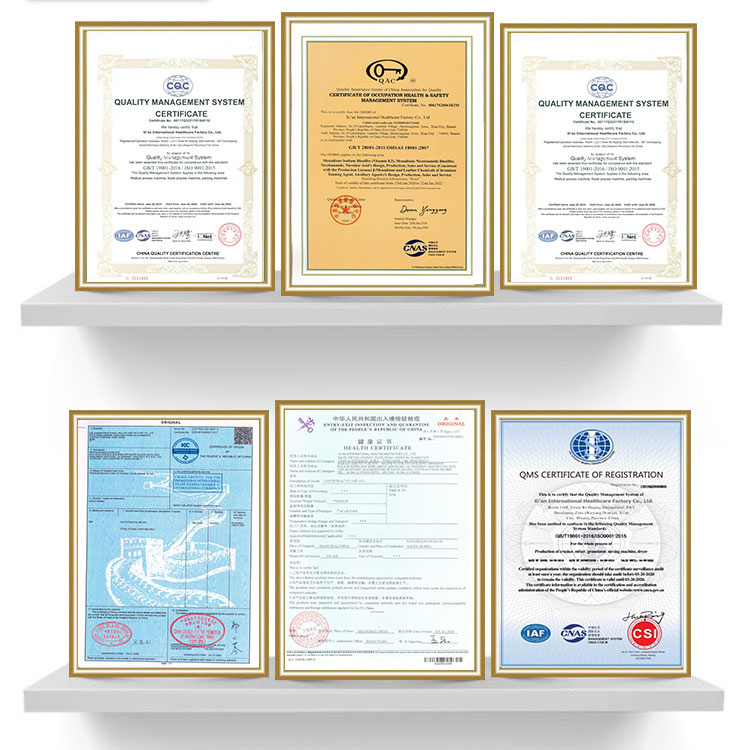Phone: 86-29-89601602
Mail: sales27@interlgroup.com
Add: Room 305 , 3/F , Haipai Decoration Office Building , Yudu Avenue , Yuncheng , Shanxi
Ribavirin powder Raw Materials CAS 36791-04-5
Product Overview:
Ribavirin powder, analogues of guanosine and hypoxanthine nucleoside, is a broad-spectrum antiviral drug with good inhibition against a variety of DNA and RNA viruses. Ribavirin is a colorless or white crystalline powder that is odorless and tasteless. Stable at room temperature. Soluble in water, slightly soluble in ethanol, chloroform and ether. Ribavirin powder has many sites of action, is not easy to produce drug resistance, high efficacy, low toxicity, and few side effects, and has been used in the treatment of a variety of viruses. Ribavirin is used clinically for the treatment of hepatitis C virus, respiratory synspore virus, and Lassa fever virus infections.
Ribavirin powder Raw Materials CAS 36791-04-5 Attributes
Product name:Ribavirin powder
CAS:36791-04-5
MF:C8H12N4O5
MW:244.21
EINECS:636-825-3
Specification:Ribavirin powder
Sample:Ribavirin powder Avaliable
Appearance:white powder
Storage: Cool Dry Place
Brand:Global ASAP Nutrition Factory
Shelf Life: 2 Years
Test Method: HPLC
Ribavirin powder Raw Materials CAS 36791-04-5 Details
Uses and synthesis of Ribavirin powder
Ribavirin powder, analogues of guanosine and hypoxanthine nucleoside, is a broad-spectrum antiviral drug with good inhibition against a variety of DNA and RNA viruses. Ribavirin is a colorless or white crystalline powder that is odorless and tasteless. Stable at room temperature. Soluble in water, slightly soluble in ethanol, chloroform and ether. Ribavirin powder has many sites of action, is not easy to produce drug resistance, high efficacy, low toxicity, and few side effects, and has been used in the treatment of a variety of viruses. Ribavirin is used clinically for the treatment of hepatitis C virus, respiratory synspore virus, and Lassa fever virus infections.
Mechanism of action of Ribavirin powder
Inhibit viral RNA polymerase: Ribavirin is similar in structure to guanosine nucleoside and can act as a competitive inhibitor of viral RNA polymerase to prevent the synthesis of viral RNA. Viral RNA polymerase is a key enzyme for RNA virus replication, and inhibiting the activity of this enzyme can effectively block the viral replication cycle.
Induce viral RNA mutation (lethal mutation): Ribavirin can be incorporated into viral RNA molecules, causing incorrect incorporation of the viral genome and increasing the viral mutation rate. Excessive mutations may cause loss of viral gene function, resulting in "lethal mutations", and ultimately causing the virus to be unable to replicate and spread effectively.
Inhibit guanine nucleoside monophosphate (GMP) synthase: Ribavirin can inhibit intracellular inosine monophosphate dehydrogenase (IMPDH), which is a key enzyme for GMP synthesis. GMP is a precursor for the synthesis of purine nucleotides, which are important components of RNA and DNA. Inhibiting GMP synthesis may indirectly inhibit the synthesis of viral nucleic acids.
Drug interactions of Ribavirin powder
Drugs that enhance the toxicity of ribavirin:Zidovudine (AZT): Combination with ribavirin may increase the toxicity of zidovudine, especially aggravate anemia. Co-use should be avoided.
Didanosine (ddI): Combination with ribavirin may increase the risk of pancreatitis and lactic acidosis, and co-use is contraindicated.
Drugs that affect the efficacy or toxicity of ribavirin:
Interferon-α: Ribavirin is often combined with interferon-α to treat chronic hepatitis C. Interferon-α may enhance the antiviral effect of ribavirin, but it may also increase the risk of adverse reactions, such as anemia and depression. Co-administration requires close monitoring.
Direct-acting antiviral drugs (DAAs): In some hepatitis C treatment regimens, ribavirin is still used in combination with DAAs. Drug interactions need to be evaluated based on the specific DAA regimen.
Combined use with bone marrow suppressive drugs: such as chemotherapy drugs, immunosuppressants, etc., may synergistically aggravate bone marrow suppression, increase the risk of anemia, leukopenia, thrombocytopenia, etc., and need to be used with caution and closely monitor blood counts.
Combined use with immunosuppressants: such as cyclosporine, azathioprine, etc., ribavirin may enhance the effect of immunosuppressants and increase the risk of infection. It needs to be used with caution and closely monitor immune function and infection.
Combined use with other drugs that may cause anemia: such as sulfonamides, chloramphenicol, primaquine, etc., may synergistically aggravate the risk of anemia, and need to be used with caution and monitor blood counts.
Indications of Ribavirin powder
Respiratory syncytial virus (RSV) infection: Mainly used for severe RSV pneumonia, especially RSV infection in infants and immunocompromised people. Usually administered by nebulized inhalation.
Chronic hepatitis C (HCV): It was once an important component of interferon combined therapy for chronic hepatitis C. With the development of direct antiviral drugs (DAAs), ribavirin has declined in the treatment of hepatitis C, but it may still be used in combination with DAAs in certain genotypes of hepatitis C or specific patient groups. Usually administered orally.
Viral hemorrhagic fever: For example, Lassa fever, Crimean-Congo hemorrhagic fever, hemorrhagic fever with renal syndrome, etc. Early use in some hemorrhagic fevers may alleviate the condition and reduce mortality. Usually administered intravenously.
Epidemic hemorrhagic conjunctivitis (pink eye): Eye drops can be used to treat epidemic hemorrhagic conjunctivitis caused by adenovirus, etc.












